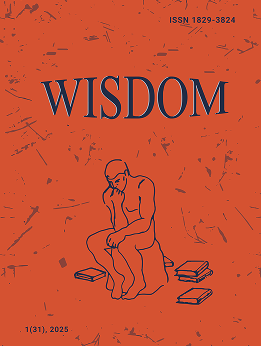Language Features in Modern Social and Cultural Space and Personal Dimension
DOI:
https://doi.org/10.24234/wisdom.v25i1.701Keywords:
language, society, culture, synergy, postmodernism, cross-cultural communication, way of thinking, spiritualityAbstract
The article is dedicated to the study of language features in modern social and cultural space, identifying the mechanisms of its transformation (methodological aspect), interrelation and reciprocal influence of language and society, language and culture (postmodernism), language and way of thinking, and human spirituality.
The authors have analyzed modern tendencies of language development, the levels of transformation and unification of linguistic variety.
Downloads
References
Batkin, L. (2001). Neuyutnost' kul'tury (Lack of comfort in culture, in Russian). Metropol: Moscow.
Epshtein, M. (2019). Budushchee gumanitarnykh nauk. Tekhnogumanizm, kreatorika, erotologiya, elektronnaya filologiya i drugie nauki XXI veka (The future of humanities. Techno humanism, erotology, electronic philology and other sciences of XXI century, in Russian). Ripol Classic.
Fedorova, L. (2021). Adaptaciya kak simptom. Russkaya klassika na postsovetskom ekrane (Adaptation as a symptom. Russian classics on the post-Soviet screen, in Russian). Moscow: Novoe Literaturnoye obozrenie.
Gumpertz, G. (1975). Tipy yazykovykh obshchestv (Types of language societies, in Russian). Novoe v lingvistike. Sociolingvistika (New in Linguistics. Sociolinguistics, in Russian), 7, 182-198.
Hymes, D. (1972). On communicative competence. In J. B. Pride, & J. Holmes (Eds.), Sociolinguistics. Selected Readings (pp. 269-293). Harmondsworth: Penguin.
Ilyin, I. P. (1996). Postmodernism (Postmodernism, in Russian). In Sovremennoe zarubezhnoe literaturovedenie: Strany Zapadnoj Evropy i SSHA: Koncepcii. Shkoly. Terminy (Modern foreign literature studies: Countries of Western Europe and USA: Concepts. Schools. Terms, in Russian (pp. 269-270). Moscow: Intrada.
Jelinek, E. (1975). Die Liebhaberinnen (Women as lovers, in German). Rowohlt Taschenbuch Verlag GmbH, Germany.
Kecskes, I. (2004). Lexical merging, conceptual blending and cultural crossing. Intercultural Pragmatics, 1(1), 1-26. DOI: https://doi.org/10.1515/iprg.2004.005
Keen, K. (1992). Competence: What is it and how can it be developed? In J. Lowyck, P. de Potter, & J. Elen (Eds.), Instructional design: Implementation issues (pp. 111-122). Brussels: IBM Education Center.
Kuhn, T. S. (1996). The structure of scientific revolutions (3rd ed.). The University of Chicago, USA. DOI: https://doi.org/10.7208/chicago/9780226458106.001.0001
Kuritsyn, V. P. (2000). Russkij literaturnyj postmodernism (Russian literature postmodernism, in Russian). Moscow: OGI.
Lapin, N. I., &Tosunyan, G. A. (2011). Obzornyj doklad o modernizacii v mire i Kitae (2001-2010) (The review report on modernization in the world and China (2001-2010), in Russian). Moscow: Ves Mir.
Levi-Strauss, K. (1985). Strukturnaya antropologiya (Structural anthropology, in Russian). Moscow: Nauka.
Lotman, Yu. M., & Uspensky, B. A. (1977). Rol' dual'nykh modelej v dinamike russkoj kul'tury (do konca XIX veka) (The role of dual models in dynamics of Russian culture (till the end of the XIX century), in Russian). Uchenye zapiski Tartuskogo gosudarstvennogo universiteta (Bulletin of Tartu State University, in Russian), 414, 3-36.
Mol, A. (1973). Sociodinamika kul'tury (Sociodynamics of culture, in Russian). Moscow: Progress.
Molchanova, G. G. (2006). Sinergiya, kak osnovnoj tipoobrazuyushchij parametr yazykovykh i mezhkul'turnykh innovacij (Synergy as the main type-forming parameter of language and cross-cultural innovations, in Russian). Vestnik MGU Seriya 19 Lingvistika i mezhkul'turnaya kommunikaciya (Bulletin of MSU Series Linguistic and Cross-Cultural Communication, in Russian), 4, 1-21.
Seabrook, J. (2012). Nobrow: Kul'tura marketinga. Marketing kul'tury (Nobrow: The culture of marketing. The marketing of culture, in Russian). Moscow: Marginem Press.
Shapir, M. I. (2000). Universum versus: YAzyk ñ stikh ñ smysl v russkoj poezii XVIII-X vekov (Universum versus: Language ñ poetry ñ meaning in the Russian poetry of XVIII-X centuries, in Russian). In Yazyki russkoj kul'tury (Languages of russian culture, in Russian). (Book 1, VIII). Moscow: Languages of Slavic Culture.
Stepin, V. S. (2011). Civilizaciya i kul'tura (Civilization and culture, in Russian). Saint-Petersburg: SpBGUP.
Downloads
Published
How to Cite
Issue
Section
License
Copyright (c) 2023 Elena KRIVOSHEEVA, Natallia ZHABO, Marina AVDONINA, Anna BOBUNOVA

This work is licensed under a Creative Commons Attribution-NonCommercial 4.0 International License.
Creative Commons Attribution-Non-Commercial (CC BY-NC). CC BY-NC allows users to copy and distribute the article, provided this is not done for commercial purposes. The users may adapt – remix, transform, and build upon the material giving appropriate credit, and providing a link to the license. The full details of the license are available at https://creativecommons.org/licenses/by-nc/4.0/.















